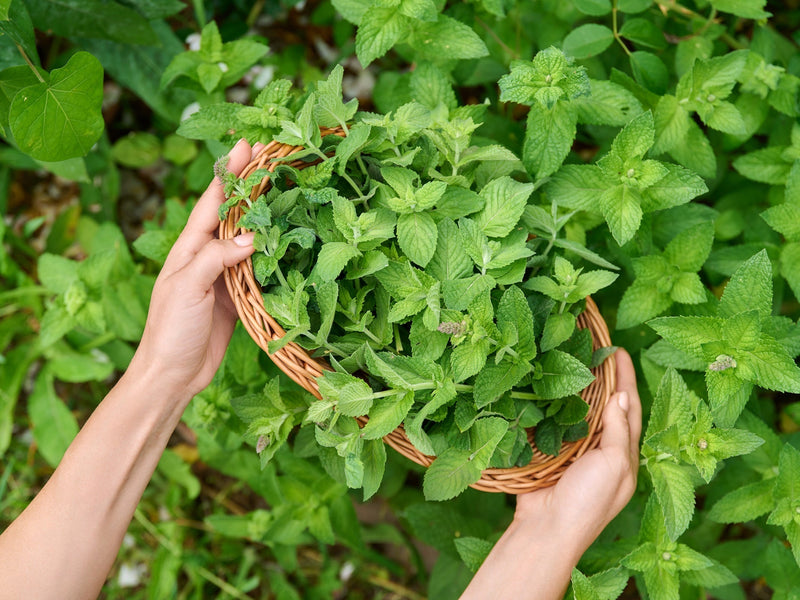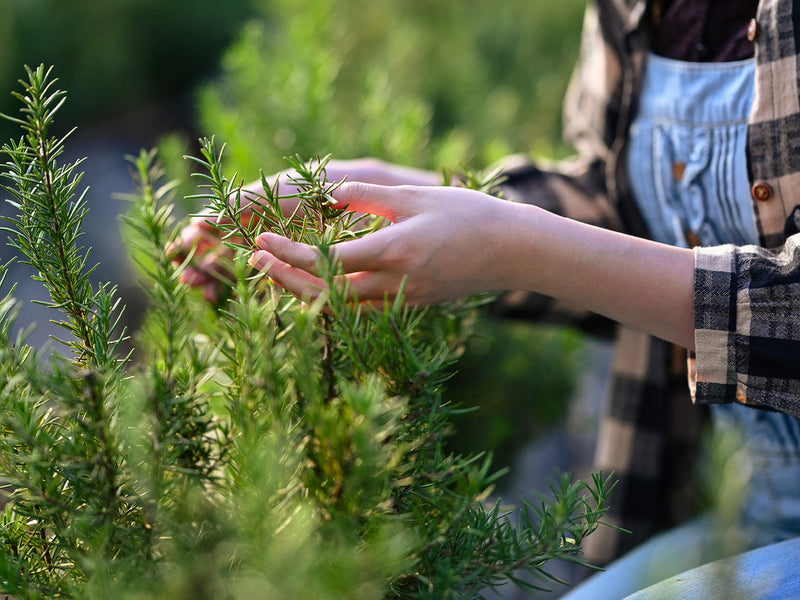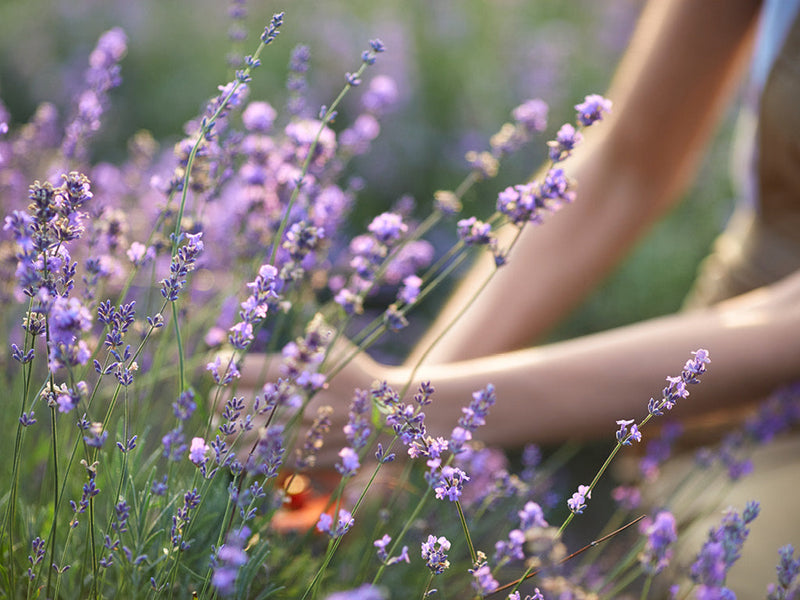Sage is hearty perennial with fragrant grayish-green leaves. Its blooms are a favorite for pollinators in the garden and I love how easy it is to grow from seed. Native to the Mediterranean, Sage has been valued for centuries for its medicinal properties, and ornamental and culinary uses. It's botanical name Salvia, derived from the Latin salvus "to save" and salvere "to heal," nods to its enduring medicinal heritage.
Growing sage from seed is not only straightforward but also very gratifying, for this perennial herb continues to thrive for years to come. This guide will walk you through the simplicity of organically growing, harvesting, and preserving this fantastic herb.
Sage Varieties
There are over 750 varieties of sage, however the most commonly grown for culinary purposes is garden sage, also known as common sage (Salvia officinalis). Common sage has lovely gray-blue leaves complemented by purple blooms. What's more, both its leaves and flowers are edible, serving as versatile ingredients in culinary creations like stuffing, sauces and meat marinades.
There are also several edible cultivars of common sage you may want to explore. Below are a list we enjoy growing for their unique attributes and qualities:
Tricolor Sage: Its leaves have marbled patterns of grey-green, white, and purplish-pink hues.
Purpurea: This sage, as the names suggests, has lovely purple leaves.
Rosea: This variety showcases pink blooms instead of the usual lavender-blue.
Aurea: A variation with golden leaves, also called golden sage.

When to Start Sage Seeds
Sage can thrive indoors in a sunny windowsill or in a hydroponic or aeroponic system. It can also be started indoors in small containers and transplanted outdoors, or directly sow into an outdoor garden.
If you're starting your sage indoors, which is what we recommend, you should plant your seeds 6 to 8 weeks before the last spring frost. If you want to forgo the transplanting process and plant your sage directly in the ground outside, wait to sow your seeds until 1 to 2 weeks after the last spring frost (find out when your last spring frost date is here)
How to Grow Sage
Getting Started
Choosing a good spot for your sage seedlings or transplants is crucial for maximum growth. Remember, sage is a perennial plant, which means it has a growing lifespan of two or more years, so pick a spot that will be good for years to come.
Your ideal planting area should be in full sun though sage can handle partial shade. It's also important to plant your sage in soil that drains well, as moist, soggy soil is bad for sage. Your sage will need room to grow, so plant your seedlings or transplants a minimum of 12" apart, with 20" to 24" inches between each row. For both indoor and outdoor growing, start your seedlings at a depth of ¼".
If you're using seed trays for indoor sowing, plant 3 seeds per cell. For starter 4" pots, plant 8 to 10 seeds per pot, evenly spaced out.

Temperature
Ideally, the outdoor temperature should be at least 50 degrees when you start your seeds or transplant your sage plants to your outdoor garden. The soil temperature should be between 60 and 70 degrees.
Light
There are very few herbs and vegetables that don't crave sunlight in order to grow, and sage is no different. Sage plants need a minimum of 6-8 hours of sunlight a day. Sage plants do tolerate some shade but prefer full sun. If you're using a grow light to grow sage indoors, keep lights on your sage plant for 12-16 hours per day.
Water
Sage needs consistent, even watering from the during germination. However, it's important that you don't overwater sage so that the soil becomes soggy or wet.
Once established, sage prefers soil more on the dry side. Your sage leaves will have the most flavor if you let the soil dry a bit between waterings.
Air Flow
Whether you're growing your sage indoors or outdoors, airflow is crucial. For indoor growing, you should keep a small fan on the seedlings to keep constant airflow. For outdoor growing, the wind and mother nature will do the job for you.
Transplanting Your Sage Plants
Hardening off is the process of moving plants outdoors for part of each day to gradually introduce them to direct sunlight, dry or moist air, and cooler nights.
If you are moving your seedlings to an outdoor location, you should harden off your plants over the course of 1 week, gradually increasing their time spent outdoors each day.
In most cases, your herb seedlings will be ready to transplant about 6-8 weeks after planting or when they have grown to approximately 2-4 inches above the top of the pot rim.
Preparing your Seedlings for Transplant
If possible, select a transplant day that is overcast, and plan to move your herbs in the early morning to avoid the harsh midday sun. Prepare your seedlings for the impending move by watering them about 2 hours before you plan to transplant. Watering makes your plants stronger and more resilient for the move, and it also moistens and loosens the soil so it can break apart easily, which is very important.

- Transferring Sage to Pots
If transplanting sage to a larger container, choose one that is at least 10" in diameter and at least 8" deep. Make sure it has good drainage holes, as your growing herbs don’t like “wet feet.”
- Transferring Sage to a Garden Bed
For transplanting sage to your garden bed, choose a spot with full sun, well-draining soil and that's rich in organic matter. Space your plants 12" apart.
Fertilizing
Herbs typically need only light fertilization to excel in your indoor or outdoor garden. A balanced organic all purpose fertilizer, such as our 4-4-4 All Purpose Fertilizer, is recommend for monthly feeding.
For outdoor planting, adding compost as a mulch around your sage plants will help with moisture retention and improve drainage.
Pruning and Harvesting
Proper pruning will make for a fuller, healthier, and more productive plant. Make the most of your sage by pruning and harvesting using the steps below.
- It is recommended to avoid harvesting leaves from your sage plant in its first year. This allows the plant to establish good roots and a solid frame. If you do plan on harvesting in the first year, do so lightly.
- Once your sage plant is well established, you can pick off leaves as needed.
- In its second and subsequent years, do a large harvest about twice during each growing season. This will encourage growth and keep your plant rounded and evenly shaped. Cut the sage stems back, harvesting no more than half the total volume of the plant.

While sage is a perennial that will last for several years, they typically become woody and less productive after 3-5 years and may need replacing. You can always start new plants with seeds or by using plant cuttings from your existing sage plants.
Pests and Diseases to Watch Out For
While sage is known for its resilience and resistance to pests and diseases, occasional issues may arise in the herb garden. Here some problems and conditions that may affect sage.
Common Sage Pests
Aphids: Aphids are small, sap-sucking insects that can weaken sage plants and spread diseases. Look out for clusters of tiny, soft-bodied insects on the leaves and stems. To combat aphids:- Blast them with a strong stream of water to physically remove them.
- Introduce beneficial insects, such as ladybugs or lacewings, which feed on aphids.
- Spray a homemade organic soap solution on the affected areas. To make the solution use 1 tablespoon organic soap (I use Dr. Bronners Peppermint Castile soap) to one quart of warm water.
Common Sage Diseases
Powdery Mildew: Powdery mildew is a fungal disease that appears as a fine white coating on the leaves of sage plants. It can hinder growth and affect the overall health of the plant. To control powdery mildew:
- Ensure proper spacing between sage plants to allow for good air circulation.
- Avoid overhead watering and always water at the base of the plant.
- Remove and destroy infected leaves to prevent further spread.
- Ensure that sage plants are grown in well-draining soil in full sun.
- Water plants moderately, allowing the soil to dry slightly between waterings.
- Apply a layer of organic mulch around the base of the plants to maintain soil moisture balance.
Sage Storage and Preservation
After a successful harvest, it's essential to properly store and preserve sage to maintain its flavor and fragrance. When done properly, you can enjoy your sage throughout the year by following the proper techniques. Here are some tips for storing and preserving sage.

Drying Sage: Drying sage is the recommended method for storing sage if you want to preserve its flavor and aroma. Here's how it works.
- Gather small bunches of sage stems and hang them upside down in a well-ventilated area, away from direct sunlight. Your stems should be 6" to 8" long.
- Ensure the sage bunches are fully dry before removing the leaves from the stems.
- Once dry, crumble the leaves and store them in airtight containers away from light and moisture.
- Label the containers with the date of drying to ensure freshness.
- Wash and dry sage leaves thoroughly.
- Place individual leaves or small clusters in a single layer and freeze them until firm.
- Transfer the frozen sage leaves into airtight freezer bags or containers.
- Label and date the containers for easy identification.
- Wash and dry fresh sage leaves.
- Place the leaves in a clean, sterilized jar and cover them with oil or vinegar of your choice.
- Seal the jar tightly and store it in a cool, dark place for at least two weeks to allow the infusion process.
- Strain the oil or vinegar, discard the leaves, and transfer it to a sterilized bottle for long-term storage.
Good Companion Plants For Sage
Companion planting is a gardening technique that involves cultivating compatible plants near each other to enhance growth, repel pests, and improve overall garden health. Here are some excellent companion plants for sage.
- Rosemary - Sage and rosemary are natural companions; they thrive in similar growing conditions and complement each other's flavors. They also repel certain pests, including cabbage moths and carrot flies, when planted together.
- Thyme - Thyme and sage make great companions, as they have similar water and sunlight requirements. Planting thyme near sage can help deter pests such as cabbage worms and whiteflies.
- Lavender - Lavender and sage are a visually appealing and aromatic combination. Lavender's strong fragrance can help repel pests like aphids and mosquitoes, benefiting the nearby sage plants.
- Marjoram/Oregano - They are part of the same plant family as sage. Their growth habits and care requirements are similar. These can be planted together to create a beautiful and flavorful herb garden.
Final Thoughts About How to Grow Sage
Thanks to its hardiness and the fact that it's a perennial that lasts for many years, sage is a must have for any garden. I hope you enjoy this versatile herb and it's many wonderful qualities!
Happy Growing!
![]()









